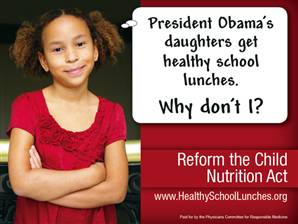8-year-old wants more veggies at school

Public school lunches are the target of a new campaign in Washington, D.C. The Physicians Committee for Responsible Medicine created a poster to influence Congress to reform the federal Child Nutrition Act. The campaign seeks to improve the nutritional content of lunches with more vegetables, fruits and low-fat options.
8-year-old Jasmine Messiah goes to public school in Miami, Florida. She wrote a letter to President Obama’s children, Sasha and Malia, who go to a private school that offers vegetarian meals to its students. Jasmine asked for help in changing her school menu, and in doing so, became the poster-child for the campaign.
 Jasmine is shown in this photo with the words “President Obama’s daughters get healthy school lunches. Why don’t I?” The law is before Congress for reauthorization. The posters are plastered around the Capitol in order to get lawmakers’ attention.
Jasmine is shown in this photo with the words “President Obama’s daughters get healthy school lunches. Why don’t I?” The law is before Congress for reauthorization. The posters are plastered around the Capitol in order to get lawmakers’ attention.
Childhood obesity is on the rise with one in three children born in 2000 expected to develop diabetes during their life. “Scientific evidence shows that consuming more plant-based foods can help prevent obesity, heart disease and diabetes,” reports the Physicians Committee.
Update: Jasmine’s efforts paid off. Florida passed a law in 2011 that goes into effect in 2012. The state will take over the federal lunch program in public schools. The goal is to use more Florida-grown fresh fruit and vegetables on school menus.
In a school district in Maine, 40% of the food served is produced locally. Fresh produce, blueberries, corn and potatoes are a standard at Portland, Maine public schools. Senior, Libby Emerson, commented that “When we come in and we can get fruit like that it helps us have our energy to carry on through the day…” Another senior, Tyler McCormick, added that “It’s not junk food or anything like that so it keeps the energy there.”
In January, 2012, the U.S. Department of Agriculture announced new nutrition standards that start in July, 2012 and phase in over the next three years. They require schools to add more fruits and vegetables to lunch and while gradually reducing the amount of sodium and trans fat. The rules also set calorie limits for the millions of meals served through the National School Lunch Program.
Update: In September, 2012, New York City banned the sale of all sugar drinks and sodas larger than 16 ounces. This is the first such ban aimed at reducing the intake of fattening beverages. Vendors can be fined up to $200.00 for each violation of the ban. The latest: The law was scheduled to go into effect on March 12, 2013. However, a court stepped in the day before and invalidated the law. The judge said it was “arbitrary and capricious” since it didn’t apply to all businesses in the city – some were excluded from the ban. Then in July, 2013, an appeals court upheld the lower court’s ruling stating the mayor overreached his legal authority in banning the drinks. The doctrine of separation of powers leaves law making to the legislative branch, not the executive. This recent decision is expected to be appealed to the state’s highest court.


